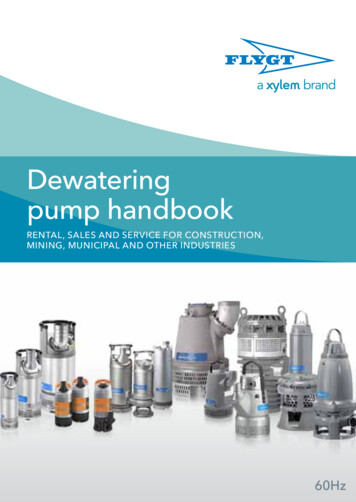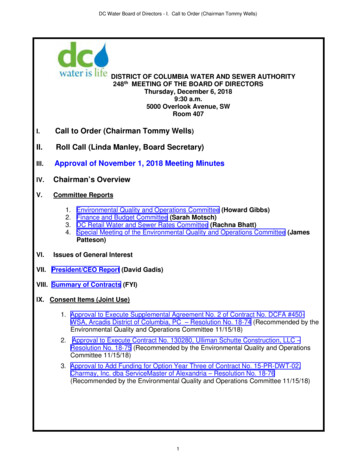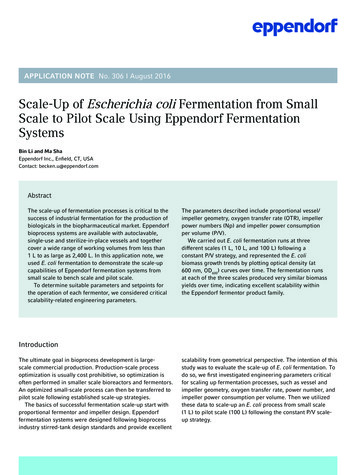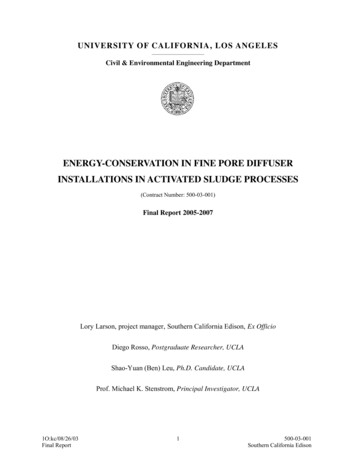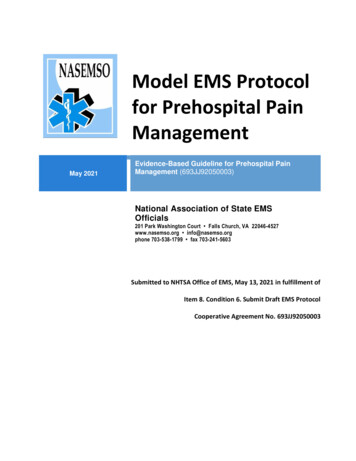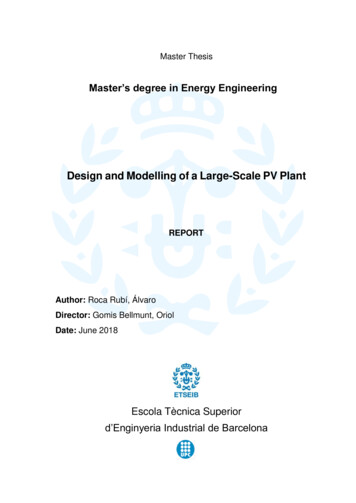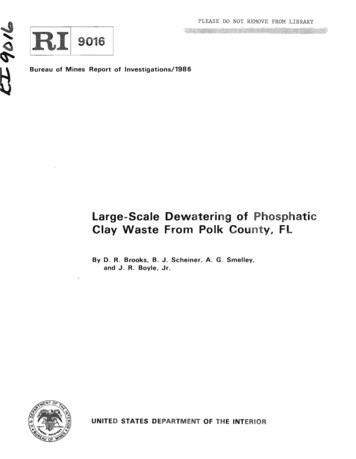
Transcription
PLEASE DO NOT REMOVE FROM LIBRARYiRIi i901SBureau of Mines Report of Investigations/1986Large-Scale Dewateri ng of Phosphati cClay Waste From Polk Cou nty, FLBy D. R. Brooks, B. J. Scheiner, A. G. Smelley,and J. R. Boyle, Jr.UNITED STATES DE PARTMENT OF TH E INTERIOR
Report of Investigations 9016Large-Scale Dewatering of PhosphaticClay Waste From Polk County, FLBy D. R. Brooks, B. J. Scheiner, A. G. Smelley,and J. R. Boyle, Jr. ECEIVt:::DRItAU M INE JUN 05198'·UNITED STATES DEPARTMENT OF THE INTERIORDonald Paul Hodel, SecretaryBUREAU OF MINESRobert C. Horton, DirectorThis report is based upon work done under an agreement between the University of Alabama and theBureau of Mines.
Library of Congress Cataloging in Publication Data: -Large-scale dewatering of phosphatic clay waste fromPolk County,FL.(Report of investigations; 9016)Bibliography: p.8.Supt. of Docs. no.: 128.23: 9016.1. Phosphate industry-Florida-Polk County-Waste disposal. 2.Clay wastes-Dewatering. I. Brooks, D. R. (Donald R.l. n. Series:Report of investigations (United State s . Bureau of Mines) ; 9016.TN23.U43[TD899.P45]6228 (628.5'42]86-600016
CONTENTSAbstract . . . .Introduction . . . . . . . . . . . . . . . . . . . . . . . . . . . . . . . . . . . . . . . . . . . . . . . . . . . . . . . . . . . . . . . .Acknowledgments . . .u II; Small-scale experiments Large-scale experiments . . . . . . . . . . . . . . . . . . . . . . . . . . . . . . . . . . . . . . . . . . . . . . . . . . . . . . .Conclusions . . . . . .References . . . " . .1233388ILLUSTRATIONS1.Flowsheet for the FTU . . . . . . . . . . . .2.3.Dewatering of clay waste on a static screen Dewatering of clay waste on a trommel screen Dewatered material in the disposal pit 22 days after filling was completed.4.4557TABLES1.2.3.4.Averages of small-scale testing . . . . . . . . . . . . . . . . . . . . . . . . . . . . . . . . . . . . . . . . . . . .Typical results obtained during FTU experiments Test results from filling of pit at the Fort Meade plant Consolidation of clay waste in pit from FTU operation 3467
UNIT OF MEASURE ABBREVIATIONS USED IN THIS REPORTftfootlbpoundgalgallonlb/stpound per short tongal/mingallon per minutepctpercenthhourr/minrevolution per minuteininchwt petweight percent,!
LARGE.SCALE DEWATERING OF PHOSPHATIC CLAY WASTEFROM POLK COUNTY, FLBy D. R. Brooks, 1 B. J. Scheiner, 2 A. G. Smelley, 3and J. R. Boyle, Jr.402ABSTRACTThe Bureau of Mines has tested a dewatering technique for phosphaticclay waste. The technique utilizes a flocculant, polyethylene oxide(PEO), that forms strong, stable flocs that can be dewatered on a staticscreen followed by further dewatering on a rotary screen or trommel. Infield tests conducted in central Florida, clay wastes containing approximately 4 pct solids have been consolidated to greater than 20 pct solids. The rate at which PEO-treated material continues to dewater ina mine cut also was monitored. Preliminary results indicate that PEOtreated material will dewater to 30 pct solids in 80 days. Pretreatmentof phosphatic clay waste with lime lowers the PEO dosage required fordewatering.1Metallurgist.2Supervisory metallurgist.3Supervisory research chemist.4Mining engineer.Tuscaloosa Research Center, Bureau of Mines, Tuscaloosa, AL.
2INTRODUCTIONPhosphatic clay waste is one of theprincipal waste products resulting fromthe mining and benefication of Floridaphosphate ore.This wastematerial,which is comprised of u1trafine particles(70 pct less than 1 m), responds poorlyto conventional solid-liquid separationtechniques and is currently disposed ofby impoundment behind earthen dams.The overall natural settling rate ofphosphatic clay waste is extremely low(l).5 Generally, impounded clay wastesthicken from a nominal 3 pct solids to10 pct solids in about 3 months. Densification to about 18 pct solids may require a year, and to reach solids contents of 20 pct or higher may requireseveral years. Data indicate that approximately 90 pct of the water pumped tothe settling pond is eventually recovered. The remaintng 10 pct of the waterlost by storage with the waste clays andby evaporation amounts to about 5 st foreach short ton of phosphate concentrateproduced (2).The discharge :rate of phosphatic cLaywaste to settling areas ranges between20,000 and 80,000 gal/min. To accommodate the waste, impoundments covering 400to 600 acres, with dam heights rangingfrom 20 to 40 ft, are required ( -1). Atpresent, there are approximately 80,000acres of active and inactive clay settling areas in Florida.To eliminate the use of abovegrounddisposal, which appears to be the ultimate goal of the State of Florida, newtechnology is required to process thewastes generated by most of the Floridaphosphate mines. To use only mined-outareas for disposal of the clay wastes requires that the solids content of thematerial be consolidated from a nominal3 pct to a final 30 to 38 pct. Generally, at this degree of consolidation,the volume of clay waste mixed with thesand from the phosphate beneficiation5Underlined numbers in parentheses refer to the list of references at the endof this report.sequence would fit into the mine cutand eliminate the need for abovegroundstorage.The Bureau of Mines has tested a dewatering technique forphosphatic claywaste that may assist in eliminatingstorage by impoundment (4-10). A portionof the water now being los using conventional waste disposal methooS-also can berecovered, and at the same time the dewatered solids produced may be more suitable for land reclamation. The procedureconsists of flocculating the clay wastewith a long-chain polymer, polyethyleneoxide (PEa). Combining the phosphaticclay waste with PEa forms strong f10cswhlch are tough enough to be dewatered ona screen. In previously reported work,this technique was tested using a fieldtest unit (FTU) at Estech General Chemical Corp.'s Silver City Mine, near Bartow, FL, and at Occidental Chemical Co.'sSuwannee River Mine, near White Springs,FL. At feed rates between 60 and 165gal/min, the FTU was able to consolidatec.lay .a.s.te f.rUID.-a0.mi.na1 3 lLct solids to20 pct solids (6, 11). To determine ifthe PEa-treated -material continued toconsolidate, the treated clay wastes werepumped into storage pits. The pits weresampled over a period of time to determine the solids content. At both sites,the clay waste consolidated to approximately 27 pct solids in 60 days. At theSilver City Mine, an additional 30 dayswas needed to attain 30 pct solids. Theclay waste at the Suwannee River Mineneeded an additional 80 days to consolidate to 30 pct solids (6, 11).This report describes further testingof the PEa dewatering technique. At therequest of the Mobil Chemical Co., thesmall-scale unit (8 to 18 gal/min) andthe FTU (200 gal/min) were operated atMobil's Fort Meade Mine. The small unitwas used to develop the parameters ofoperation for the FTU. The FTU was usedto fill a pit with dewatered clay wasteso that any further consolidation of thewaste with time could be monitored.
3ACKNOWLEDGMENTSauthors wish to express appreciation toAl Propp, project manager, for coordinating the work at the Fort Meade Mine.This research was conducted under amemorandum of agreement between the Bureau of Mines and Mobil Chemical Co. TheSMALL-SCALE EXPERIMENTSCommercially manufactured PEO was usedPEO concentration, flow rate, and mixeras the f10ccu1ant inall dewateringspeed affected the dewatering. Since thetests. The polymer is a linear, non character of clay waste changed from hourionic, water-soluble molecule composed ofto hour, the results of individual testsrepeating units of CH 2 CH 2 -O and having awere grouped together to obtain a trend.molecular weight of approximately 5 mi1The data were divided into three majorlion. Solutions containing 0.25 pct PEOgroups:(1) dewatering the clay wastewere - p.r-ep-ar.ed- f-rom the solid po1yme.J;. - -f-J;.omt-he sump without any treatment,These solutions were then diluted to con(2) addition of lime prior to PEO f10 cu centrations between 0.01 and 0.05 pct.1ation, and (3) addition of 3 to 10 1b/stDeep-well water was used for preparationlime, mixing, and allowing the 1imeand dilution of the PEO solution.treated clay waste to stand overnight.Initial tests were conducted, usingFor each of these groups all the test resmall-scale equipment with a throughputsu1ts were averaged to obtain a singlecapacity of 8 to 18 gal/min, to determinenumber for dosage and solids content.how this clay waste responds to f1occu1aThe average results are shown in table 1.tion with PEO. Clay waste used in theseThe averages given in table 1 represent aexperiments was obtained from the pumpingwide range of results; for example, thesump at the Fort Meade plant. The claysolids content ranged from 7 to 21 pctwaste entered a 400-ga1 tank and was thenand the PEO dosage f r om 0.88 to 2.53 1b/pumped to a mixer, where PEO was added.st. The results indicate that PEO willThe resulting f10cs were dewatered on aflocculate this clay waste and that thestatic screen, followed by further dewaresulting floc could be dewatered on thetering in a tromme1 screen. Tests weretromme1 screen. Also, the addition ofconducted to determine how variables suchlime lowers the PEO dosage.as lime addition, aging time, PEO dosage,LARGE-SCALE EXPERIMENTSBased on results of the small-scale experiments, the mobile FTU was moved tothe test site. Figure 1 shows the flowsequence for the FTU. Clay waste wassupplied to the unit from the plant claywaste pipeline. The clay waste from thepipeline flowed· to a holding tank-.- Fr-omthis tank it was pumped to the FTU at apredetermined rate. The static screen,shown in operation in figure 2, is 8 ftwide by 4 ft high and has openings 0.03in wide. The tromme1 screen has a 3-ftdiam, is 12 ft long, and was constructedof 10 esh stainless steel. The first-4 ft f-rom the feed end was lined with asecond screen of 48-mesh stainless steelTABLE 1. - Averages of small-scale testing dataNo treatment.Lime addition.Lime addition plus standing overnightPEO dosage,1b/st1.61.31.1Dewatered product,pct solids16.414.716.3
40.25 pctWaterPEO holdingtanksholding0.05 ondClaywasteholdingtankClayL.---""' --wasteinFIGURE l. - Flowsheet for the FTU.to prevent loss of solids as the flocculated material flowed onto the screen.During operation,the clay waste forms aroll in the trammel, as shown in figure 3.In addition to the dewateringscreens, the equipment includes a systemfor making PEO solutions; holding tanksfor PEO solutions and the clay waste; andvarious pumps to transport solutions,slurries, and consolidated material.Initial experiments were conducted todetermine the optimum mixing speed forthe clay waste-PEO mixer. It was determined that 45 r/min gave the best results. Based upon this information, theFTU was operated at 45 r /min. Resul ts ofa series of tests, shown in table 2, indicate that 19.5 to 25.1 pct solids canbe obtained with 0.99 to 1.33 Ib/st PEO.TABLE 2. - Typical results obtained during FTU experimentsFeed solids content,wt pctLime addition,Ib/stPEO dosage,lb/stTrommel discharge,wt 323.022.123.625.124.224.024.5l-c}.520.5
5FIGURE 2. - Devyatering of clay waste on a static screen.FIGURE 3. - Dewatering of clay waste on a trommel screen.
6Based upon these results, a test program was initiated to fill the pit adjacent to the test unit with dewateredclay waste. The pit was filled beginningon October 14, 1983, and ending 10 dayslater on October 24, 1983. The unit wasoperated each day as long as clay wastewas discharged from the plant. On somedays clay waste was available only forshort P-er ods of time. The unit: was operated at a flow rate of 200 gal/min inthe following manner.Clay waste from the plant was placed inthe holding tank, and lime was added.For the test, the average solids contentof the feed was 3.95 pct, as shown intable 3, and the lime dosage averaged 3.8lb/st. Clay waste from the plant wasadded to the tank at the rate of 200 gallmin and was pumped out of the tank atabout 300 gal/min, with 200 gal beingsent to the dewatering unit and 100 galrecycled back to the top of the tank.This kept the tank stirred. The feed tothe tank from the slime line varied insolids contento; recycling -a---po-r-t--i{)ftofthe slime back to the tank provided amore uniform feed to the dewatering unit.The operating volume of the tank was approximately 14,000 gal.TABLE 3. - Test results from filling of pit at the Fort Meade plantDayOperating time,n1 2 3 4 5 6 7 8 9 Total or wtd av 01.001.001.001.2529 . 25Feed solids,pct4.203.804.064.294.214.314.324.35-3 295.514.574.173.564.244.604.283.771.692.363. 95Trommel dischargesolids, 1.319.119.618.619.620.823.025.721.9--.PEO 881.001.041.06.93.56.91
7Results of the tests, summarized intable 3, show that the average solidscontent placed in the pit was 21.9 pct,with an average dosage of 0.91 lb PED pershort ton of solids.The volume of dewatered material pumpedto the pit during the test program wasapproximately 53,000 gal. The water table in the center of the pit was 44 inabove the- -bottem, and the pit was filledto a depth of 86 in. During the fillingthe water was not pumped from the pit,but was allowed to flow into the groundthrough the walls of the pit as dewateredmaterial was placed into the pit. At theend of the filling,the water level ontop of the solids was 1 to 2 in.The amount of dewatering that occurredin the pit was determined by taking samples from the middle of the pit. Resultsare shown in table 4.TABLE 4. - Consolidation of clay wastein pit from FTU operationDepth below surface, ft1 2 3 4 5 Average . .0 After22 days24.425.926:527.529.826.8After80 days29.430.027.930.231.929.9The data indicate that 30 pct solidswill be reached in less than 3 months.In figure 4, a view of the pit 22 daysafter filling shows that the outside edgeof dewatered material developed cracksas it dewatered.FIGURE 4. - Dewatered material in the disposal pit 22 days after filling was completed.
8CONCLUSIONSThe phosphate clay waste from the FortMeade Mine was successfully dewatered inthe FTU to greater than 20 pct solids.These results were achieved by adding 3.8lb lime per short ton of dry solids andstirring for approximately an hour priorto PEaaddition.PEOdosagesaveraged0.91 lb/st for the operation of the unit.The dewatered clay waste continued toconsolidate when placed in a pit andreached 29.9 pct solids in 80 days.REFERENCES1I1. Lamont, W. E., J. T. McLendon,L. W. Clements, Jr., andI. L. Feld.Characterization Studies of Florida Phosphate Slimes.BuMines RI 8089, 1975,24 pp.2. Lawver, J. E., J. D. Raulerson, andC. C. Cook. New Techniques in Beneficiation of Phosphate Rock. Pres. t Soc.Min. Eng. AIME Meeting, Orlando, FL,Sept. 1978, 37 pp.; available from J. E.Lawver, International Minerals and Chemicals Corp., Bartow, FL.3. Boyle, J. R. Waste Disposal Costsof a Florida Phosphate Operation. BuMines IC 8404, 1969, 24 pp.4. Scheiner, B. J., and A. G. Smelley.Dewatering of Fine Particle Clay WasteUsing a Flocculant. Pres. at Soc. Min.Eng. AIME Meeting, Atlanta, GA, Mar.1983; Soc. Min. Eng. AIME preprint 83-2,10 pp.5. Smelley, A. G., B. J. Scheiner, andJ. R. Zatko. Dewatering of IndustrialWaste. Bumines RI 8498, 1980, 10 pp.6. Scheiner, B. J., A. G. Smelley, andD. R. Brooks. Large-Scale Dewatering ofu.s.GOVERNMt:NT PRINTING OFFICE: 1986-605-017140,021Phosphatic Clay Waste From Central Florida. BuMines RI 8611, 1982, 11 pp.7. Smelley, A. G., andI. L. Feld.Flocculation Dewatering of Florida PhosphaticClay Waste.BuMines RI 8349,1979, 26 pp.8. Smelley, A. G., R. W. Montgomery,Jr., and B. S. Hammer. Dewatering ofSlimes.U.S. Pat. 4,303,532,Dec. 1,1981.9.Smelley, A. G., and B. J. Scheiner. Synergism in Polyethylene Oxide Dewatering of Phosphatic Clay Waste. BuMines RI 8436, 1980, 18 pp.10.Application of a Dewaterto Industrial Wastes. Paings of t e Progress in theFine Particles ConferenceAL, Tuscaloosa, AL, Apr. 1-2,1981). Univ. AL, Coll. Eng. Div. Continuing Ed., 1981, 13 pp.11.Large-Scale Dewatering ofPhosphatic Clay Waste From Northern Florida. BuMines RI 8928, 1985, 9 pp.IN T . -BU.O F MIN ES,PGH.,PA. 2B244I
Clay Waste From Polk County, FL By D. R. Brooks, B. J. Scheiner, A. G. Smelley, and J. R. Boyle, Jr. UNITED STATES DEPARTMENT OF THE INTERIOR Donald Paul Hodel, Secretary BUREAU OF MINES Robert C. Horton, Director ECEIVt:::D RItAU MINE JUN 05198'· This report is based upon work done under an agreement between the University of Alabama and .
